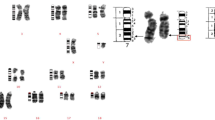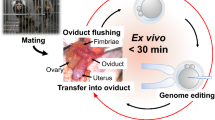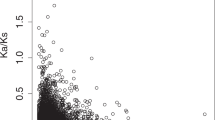Abstract
IN the female mule (Equus caballus × E. asinus), the horse (maternal) and the donkey (paternal) X chromosomes are morphologically distinguishable1,2, and the X-linked enzyme, glucose-6-phosphate dehydrogenase (G-6-PD), is present as a combination of the two electrophoretically distinct parental forms3,4. Female mule cells therefore may serve as an experimental model for the simultaneous study of both cytological and biochemical aspects of dosage compensation for X-linked loci in mammals (Lyon hypothesis5). We have demonstrated a very close correlation between late replication of either one or the other of the parental X chromosomes, and relative activity of the complementary form of G-6-PD6. In this study we have obtained further and more rigorous proof that late replication of the X chromosome corresponds to genetic inactivation at the G-6-PD locus. We have also obtained data bearing on the problem of the postulated randomness of inactivation.
This is a preview of subscription content, access via your institution
Access options
Subscribe to this journal
Receive 51 print issues and online access
$199.00 per year
only $3.90 per issue
Buy this article
- Purchase on Springer Link
- Instant access to full article PDF
Prices may be subject to local taxes which are calculated during checkout
Similar content being viewed by others
References
Bernischke, K., Brownhill, L. E., and Beath, M. M., J. Reprod. Fert., 4, 319 (1962).
Trujillo, J. M., Stenius, C., Christian, L. C., and Ohno, S., Chromosoma, 13, 243 (1962).
Trujillo, J. M., Walden, B., O'Neill, P., and Anstall, H. B., Science, 148, 1603 (1965).
Mathai, C. K., Ohno, S., and Beutler, E., Nature, 210, 115 (1966).
Lyon, M. F., Nature, 190, 372 (1961).
Cohen, M. M., and Rattazzi, M. C., Proc. US Nat. Acad. Sci., 68, 544 (1971).
Puck, T. T., Marcus, P. J., and Cieciura, S. J., J. Exp. Med., 103, 273 (1956).
Moorhead, P. S., Nowell, P. C., Mellman, W. J., Battips, D. M., and Hungerford, D. A., Exp. Cell Res., 20, 613 (1960).
Hamerton, J. L., Richardson, B. J., Gee, P. A., Allen, W. R., and Short, R. V., Nature, 232, 312 (1971).
Hamerton, J. L., Giannelli, F., Collins, F., Hallett, J., Fryer, A., McGuire, V. M., and Short, R. V., Nature, 222, 1277 (1969).
Mukherjee, B. B., Mukherjee, A. B., and Mukherjee, A. B., Nature, 228, 1321 (1970).
Giannelli, F., and Hamerton, J. L., Nature, 232, 315 (1971).
Gartler, S. M., and Linder, D., Cold Spring Harbor Symp. Quant. Biol., 29, 253 (1964).
Nyhan, W. L., Bakay, B., Connor, J. D., Marks, J. F., and Keele, D. K., Proc. US Nat. Acad. Sci., 65, 214 (1970).
Goldstein, J. L., Marks, J. F., and Gartler, S. M., Proc. US Nat. Acad. Sci., 68, 1425 (1971).
Migeon, B. R., Amer. J. Hum. Genet., 23, 199 (1971).
Hook, E. B., and Brustman, L. D., Nature, 232, 349 (1971).
Sharman, G. B., Nature, 230, 231 (1971).
Richardson, B. J., Czuppon, A. B., and Sharman, G. B., Nature New Biology, 230, 154 (1971).
Cooper, D. W., VandeBerg, J. L., Sharman, G. B., and Poole, W. E., Nature New Biology, 230, 155 (1971).
Author information
Authors and Affiliations
Rights and permissions
About this article
Cite this article
RATTAZZI, M., COHEN, M. Further Proof of Genetic Inactivation of the X Chromosome in the Female Mule. Nature 237, 393–396 (1972). https://doi.org/10.1038/237393a0
Received:
Revised:
Issue Date:
DOI: https://doi.org/10.1038/237393a0
This article is cited by
-
Age-dependency of somatic selection in South African Negro G-6-PD heterozygotes
Human Genetics (1981)
-
Primary and secondary nonrandom X chromosome inactivation in early female mouse embryos carrying Searle's translocation T(X; 16)16H
Chromosoma (1980)
-
Stochastic models for X chromosome inactivation
Journal of Mathematical Biology (1979)
-
Analysis of mechanisms regulating the expression of parental alleles at the GPD locus in mule erythrocytes
Biochemical Genetics (1978)
-
Preferential inactivation of the paternally derived X chromosome in the extraembryonic membranes of the mouse
Nature (1975)
Comments
By submitting a comment you agree to abide by our Terms and Community Guidelines. If you find something abusive or that does not comply with our terms or guidelines please flag it as inappropriate.



